How Nonprofits Can Drive Action in Times of Need (Part 2)

In Part 1 of this series, we talked about how nonprofits can further their missions and increase their impact by ensuring their digital presences are focused on audience needs and engineered to make it as easy as possible for visitors to take action. In this post, we’ll delve into specific examples from top nonprofit organizations to demonstrate how the power of digital can be harnessed to create and spread impact.
There are now innumerable tools and approaches that nonprofits can use in their digital solutions to empower constituents to take action quickly and effectively. Everything from contacting local representatives or getting the latest updates about legislations, to making donations and discovering new grant programs can be done through the touch of a button, via any number of devices, from virtually anywhere. By reducing the barriers to entry, it’s possible to get more people from all walks of life to get involved in a variety of initiatives including political, environmental, and social justice causes.
Real-Life Examples of Using Digital to Empower Users to Take Action
Influencing Legislative Action with The ACLU and The Pew Charitable Trusts
Recently, when quick action was paramount to influencing a legislative decision, I used the ACLU website to reach out to one of my local representatives. Once again, the site’s primary navigation featured a prominent link, prompting me to find out more about how I could 'Take Action'.
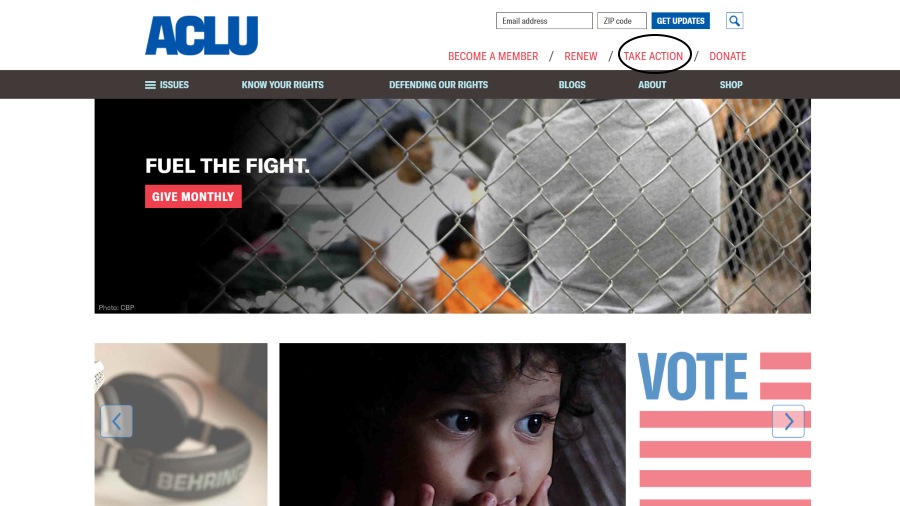
The ACLU website home page with 'Take Action' link
With another click, I was on a page whereupon entering some quick personal information (my first name, zip code, and phone number), I would receive a call back connecting me with one of my two local representatives. I selected the representative I wanted to speak to and was connected to her office instantly. I spoke with one of her staff members, reading from the script provided on the page. The process was frictionless.
The seamlessness of this transaction no doubt garnered a larger volume of calls than, say, if the ACLU had listed hundreds of names and numbers of state representatives to peruse through, or even provided a search-by-state directory. What might at first appear to be a rather insignificant nuance from making a call to receiving a call is actually quite profound; the extra step required to find a number and then dial it is often just enough of a barrier to cause people to postpone the task, and risk losing their participation altogether. Receiving a call back, in contrast, implies that there will be a live voice on the other side of the line (which was the case when I signed up online to receive a call back). Having this interaction happen within a minute or so of entering my number further incentivized me to participate as I knew in advance the amount of my time that I would need to commit to the task and was able to accommodate it in my schedule.
This level of functionality is impressive for a number of reasons. The user experience clearly follows a very specific journey with an end goal in mind — to facilitate as many calls to representatives as possible in a limited amount of time (given the time-sensitivity of legislative actions), enabling a particular vote on the featured bill. Knowing that the majority of people visiting their site want to contribute to a cause but may not know next steps, or have a lot of time to commit to finding relevant information, the ACLU created a solution that acknowledged these challenges and lessened their effect as barriers to taking action.
When I checked the site the next day, the legislation I had called about had been voted on, but I noticed that the Take Action page had already been set up for the next pressing issue, further emphasizing how dynamic, responsive, and up-to-date the site is.
Now, let’s look at how one of the most prominent nonprofit organizations in the world, the PEW Charitable Trusts, uses its website as an avenue to help its audiences communicate with and petition members of Congress regarding pressing, timely matters.
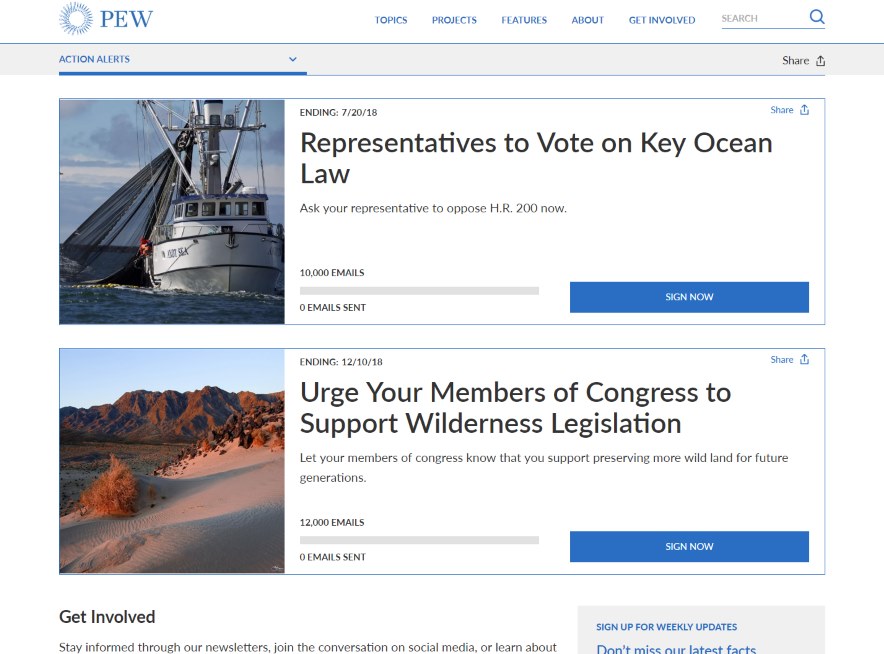
'Action Alerts' page on the PEW Trusts' site
The site’s main navigation features a ‘Get Involved’ section where visitors can find relevant issues that they can take immediate action on. Each issue is highlighted with a quick summary and other important details like the date by which action needs to be taken, the goal that the Pew Trusts is targeting to ensure that these actions (emailing representatives and spreading the word on social media) can have the desired impact, and a related CTA (call-to-action).
Selecting a specific issue to take action on by clicking the SIGN NOW button, leads visitors to a form that is simple and easy to fill out.
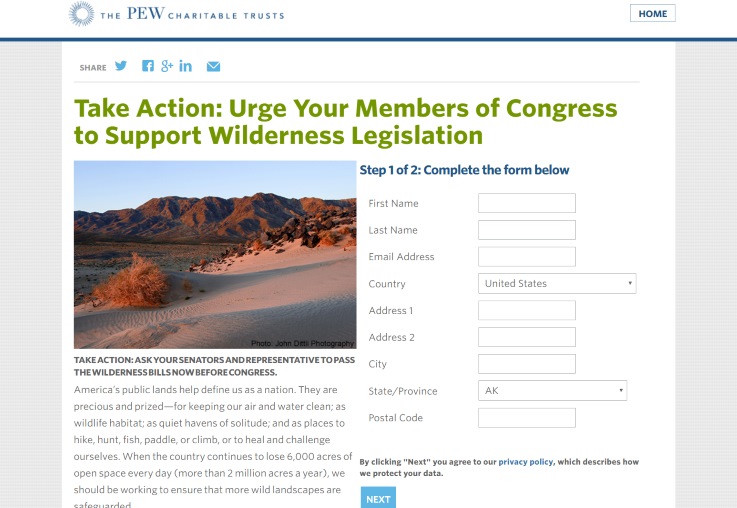
The PEW Trusts' 'Take Action' form
Submitting the form then takes the visitor to a page with pre-written email templates addressed to the relevant state representatives.
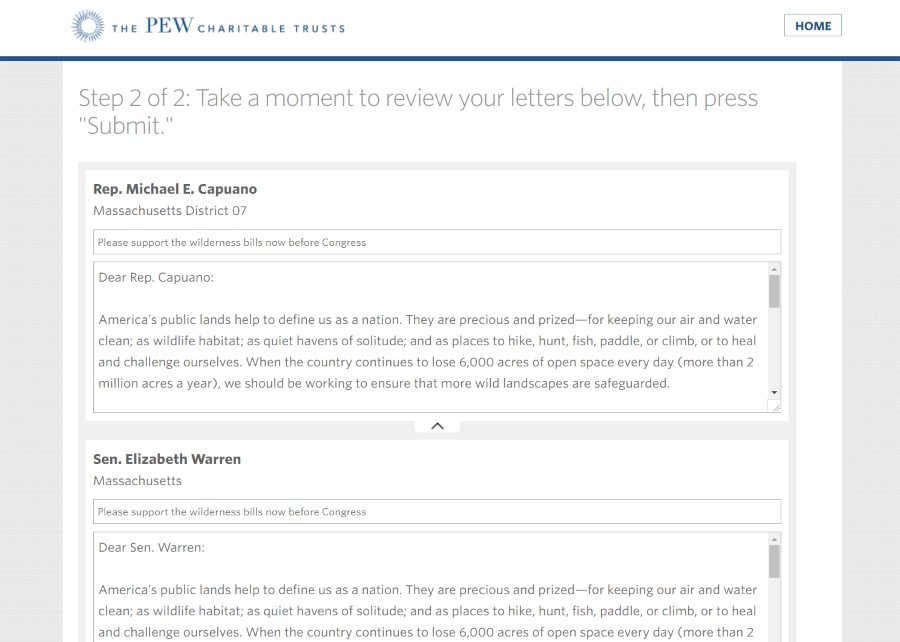
The PEW Charitable Trusts' pre-generated email to representatives
Visitors can edit any portion of these templates, including the subject and body of the emails, and then send their messages with one click of a button.
The process is frictionless and seamless. At no point do the names or email addresses of state representatives or legislators need to be known. The email templates are automatically addressed based on the information entered by the visitor. The entire transaction from the home page or other landing page to submission of the message takes under a minute and requires virtually no effort outside of entering contact information. However, the impact of constituents’ efforts like these on public policy cannot be overstated, as has been shown through various examples in both the Pew’s research as well as on Change.org, highlighting policy wins.
Grantmaking Simplified with the RWJF
Finally, let’s take a look at how the largest nonprofit in the U.S. devoted to advancing the public’s health, the RWJF (the Robert Wood Johnson Foundation), uses its digital mediums to simplify the grant application process. With a thoughtful approach that takes into consideration the pain points and needs of audiences that are seeking funding, the RWJF empowers these entities and individuals to further their efforts, in alignment with the Foundation’s mission of building a national Culture of Health.
In a number of areas across the site, grantees and grant seekers are specifically addressed and provided with prominent CTAs.
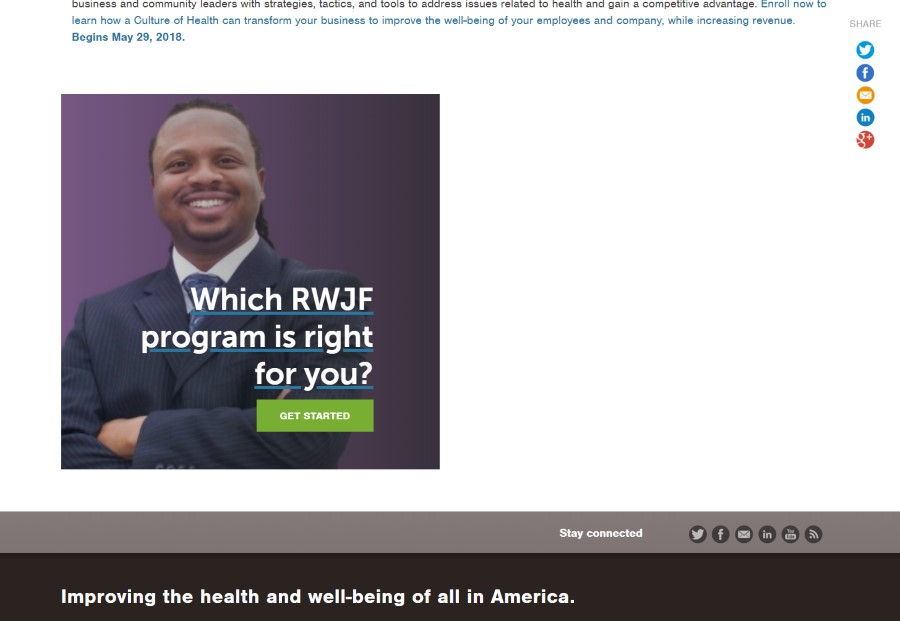
Image with CTA (call-to-action)
These CTAs lead to a Program Finder page listing numerous programs offered by the RWJF, all with a compare checkbox option to allow users to compare key details (funding amount, duration, eligibility criteria, etc.) side by side. Additionally, there is a filter option on the left-side of the page allowing users to filter grants by various facets that are relevant to them in their decision-making process. The Program Finder is like a matchmaking tool, surfacing all grant opportunities that match a candidate’s criteria (regardless of whether those particular grant opportunities are currently accepting applications).
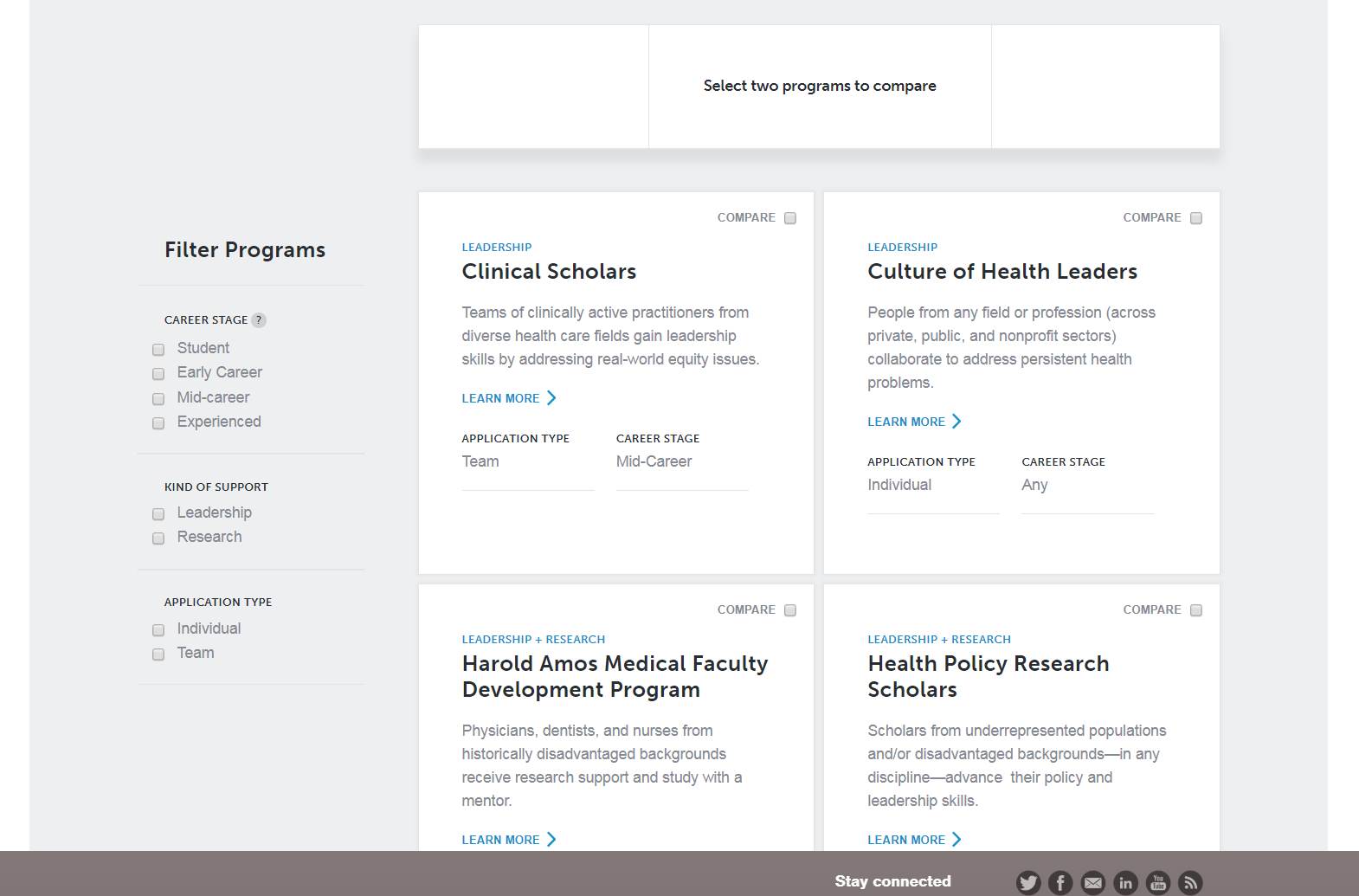
The RWJF Program Finder tool
Funding opportunities also appear on the Grants Explorer page, allowing grant seekers to view opportunities by upcoming deadlines, so they can plan their application process accordingly.
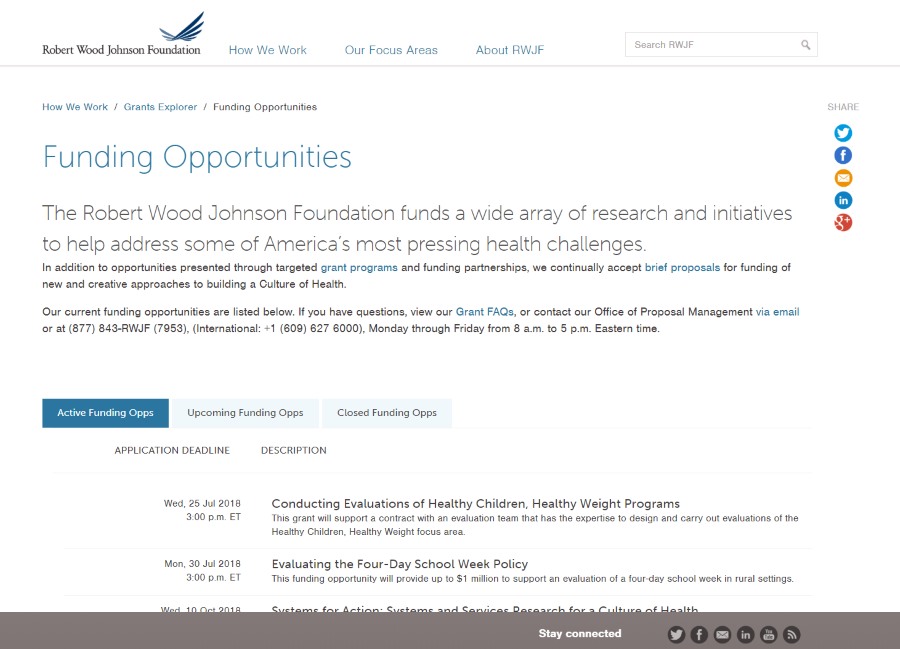
The RWJF Funding Opportunities page
Once again, with a thorough understanding of the challenges being faced by its audiences, the RWJF has created an effective solution that increases the volume and quality of grant applications (in essence, widening the top of the grant application process funnel) as well as ensuring that candidates can find what they are looking for; for the candidate, these tools make it easier to filter grants by their career stage, the type of support they are seeking (leadership or research), and whether they are applying individually or as part of a team.
The grant application process has been known among researchers to be a complex, and oftentimes tedious process. The RWJF has used its experience and expertise in this area to implement digital solutions that help make the grant discovery process simpler and more effective, removing barriers at the outset of the process, thereby increasing the probability that candidates can obtain funding.
Tailor Your Digital Presence with a Strong Understanding of Your Users and Your Desired Impact
As we can see from the examples above, a focus on the end user and subtle changes to the digital user experience and journey can have a powerful effect on the end result and help move the needle in the desired direction. Consumer-facing sites have, for a long time, tapped into the power of psychology to understand the barriers that get in the way of users making purchases. Nonprofits who understand their users’ challenges to taking action, can create effective websites and other digital solutions that empower their users rather than overwhelm them, thereby increasing their impact in the world.
Are you a nonprofit that is working on a digital initiative to spread the word and empower action on a given cause? We’d love to know what challenges you’ve faced, which approaches have worked, and results that you’ve seen to date. Join in the discussion by commenting below or reach out to us to chat further. We’d love to hear from you!



